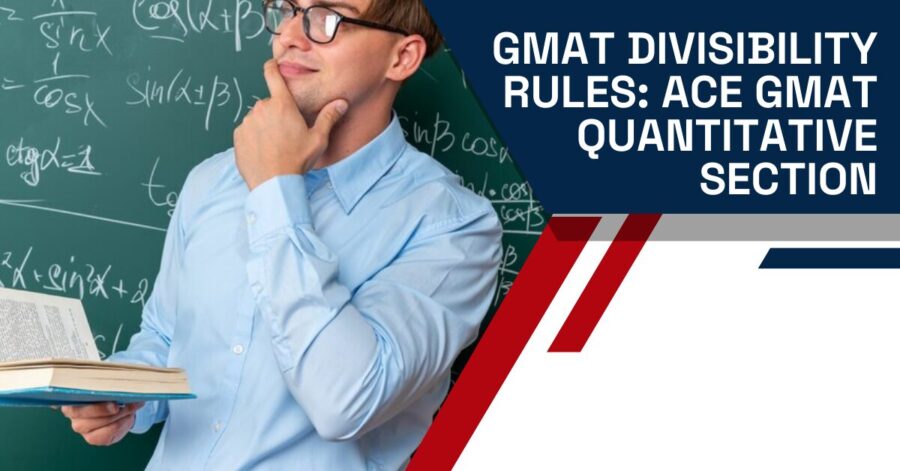3 September 2024
8 minutes read
GMAT Divisibility Rules: Ace GMAT Quantitative Section

Key Takeaways
- Mastering divisibility rules can significantly boost your speed and accuracy on the GMAT Quantitative section.
- Understanding multiples, factors, and prime factorization provides a solid foundation for tackling a wide range of GMAT math problems.
- Regular practice with official GMAT materials and free online resources is crucial for internalizing these concepts and applying them efficiently.
- Developing strong mental math skills and learning to break down complex problems can give you a competitive edge on test day.
Do you find the GMAT Quantitative section daunting, especially when it comes to divisibility rules? Many test-takers share this challenge, feeling unsure about how to tackle these questions efficiently.
Understanding divisibility rules can transform your approach to the GMAT. This blog will guide you through the essentials, making these rules clear and manageable. With this knowledge, you’ll be better prepared to ace the Quant section and achieve your best score.
GMAT Divisibility Rules: An Overview

Understanding divisibility rules is crucial for the GMAT Quantitative section. These rules help you quickly determine if a number is divisible by another without performing long division. Mastering them will save you time and increase your accuracy. Make sure to go through enough previous GMAT question papers to get a handle of the kind of questions that come in this category.
Simplify Calculations
Knowing if a number is divisible by 2, 3, 4, or 5 can simplify complex calculations. For example, if the sum of the digits is divisible by 3, then the entire number is divisible by 3. This helps you break down larger problems into manageable parts. Also, another key concept to keep in mind is GMAT order selection as it comes handy during GMAT time management.
Identify Patterns
Recognizing patterns in numbers, such as when a number is a multiple of 4 or a number is divisible by 9, can speed up problem-solving. These patterns often appear in GMAT questions, making it easier to find the right answer quickly.
Reduce Errors
Applying divisibility rules correctly reduces the chances of making mistakes. For instance, knowing a positive integer is divisible by 5 if it ends in 0 or 5 helps you quickly verify your calculations, ensuring accuracy in your answers. Start your GMAT preparation time early so that you get enough time to correct the errors.
Enhance Efficiency
Divisibility rules allow you to bypass lengthy calculations. For example, if a number’s last two digits form a number divisible by 4, then the whole number is divisible by 4. This can save precious time during the exam. This can be applied to GMAT ratio problems as well.
Strengthen Number Sense
Familiarity with these rules enhances your overall number sense. Understanding how digits interact to form even numbers, prime numbers, and multiples makes it easier to tackle a variety of quantitative problems on the GMAT. Understand GMAT questions properly for strengthening your number sense.

Number Divisible by 0
No number is divisible by 0 because division by zero is undefined. This is a fundamental rule in mathematics and crucial for GMAT problem-solving. When preparing for the GMAT, remember that 0 is divisible by any non-zero number, but no number can be divided by 0. This concept is important for both GMAT and GRE test prep. Have a clear idea of the GMAT quant topics to divide your time to each topic accordingly.
Number Divisible by 2
A number is divisible by 2 if its last digit is even. This is a quick way to determine divisibility without a calculator. In GMAT practice questions, checking if the last digit is 0, 2, 4, 6, or 8 can help you quickly determine if a number is even and hence divisible by 2. Understanding factors of 2 is crucial for solving quantitative questions efficiently. You can ace GMAT quant by mastering these tips.
Number Divisible by 3
To check if a number is divisible by 3, add up its digits. If the sum of the digits is divisible by 3, then the original number is also divisible by 3. This rule for 3 is frequently tested in GMAT problems, so practice using it in various scenarios to improve your speed and accuracy. For example, if a number’s digits are divisible by 3, you know it’s a multiple of 3. GMAT quant questions can be tricky, so make sure to practice thoroughly.
Number Divisible by 4
A number is divisible by 4 if the last two digits form a number that is divisible by 4. For example, 2024 is divisible by 4 because 24 is divisible by 4. This rule is useful for quickly determining divisibility without having to perform long division. Knowing whether a number is divisible by 4 can help in various GMAT math questions.
Number Divisible by 5
If a number ends in 0 or 5, it is divisible by 5. This is one of the simplest divisibility rules and can be applied quickly. This rule is often used in GMAT quantitative questions to narrow down answer choices. It’s important to note that a number is divisible by 5 if its last digit is 0 or 5, making it a key factor for divisibility questions. By constant practice, you can score 750 or above in GMAT.
Number Divisible by 6
A number is divisible by 6 if it is divisible by both 2 and 3. This means it must end in an even digit, and the sum of its digits must be divisible by 3. Understanding this combination rule is essential for solving more complex GMAT problems efficiently. This rule helps determine whether a number is divisible by 6, ensuring comprehensive understanding.
Number Divisible by 7
To determine if a number is divisible by 7, double the last digit and subtract it from the rest of the number. If the result is divisible by 7, then the original number is also divisible by 7. This rule may seem tricky, but with practice, it becomes easier to apply. Divisibility by 7 can often appear in challenging GMAT problem-solving questions.
Number Divisible by 8
A number is divisible by 8 if the last three digits form a number that is divisible by 8. This is useful for larger numbers. For instance, if you know the last three digits are divisible by 8, the entire number is also divisible by 8. Recognizing when digits are divisible by 8 can simplify many GMAT quantitative problems.
Number Divisible by 9
Similar to the rule for 3, a number is divisible by 9 if the sum of its digits is divisible by 9. This rule helps simplify calculations in GMAT problems, allowing you to quickly determine divisibility without lengthy division. This rule is essential for determining whether a number is divisible by 9 in GMAT practice.
Number Divisible by 10
A number is divisible by 10 if its last digit is 0. This rule is straightforward and easy to apply, making it useful for quickly checking answer choices and simplifying problem-solving on the GMAT. Knowing that a number is divisible by 10 helps quickly verify if it fits the criteria for being a multiple of 10.
Using GMAT Divisibility Rules to Answer Quant Questions Faster
Using GMAT divisibility rules can significantly speed up your problem-solving process, allowing you to answer quantitative questions more efficiently. By mastering these rules, you can quickly determine if a number is divisible by another, which helps you eliminate incorrect answer choices faster. For instance, knowing that a number is divisible by 3 if the sum of its digits is divisible by 3 can save valuable time during the test. GMAT for non-math background individuals can be a bit tricky but doable with right tips and tricks.
Resources like GMAT Club and other online communities offer free GMAT format questions and discussions where you can sharpen these skills. Additionally, the official GMAT guide includes practice problems that can help reinforce your understanding of divisibility rules, ensuring you’re well-prepared for test day.
Divisibility/Multiples/Factors: Tips and hints
Understanding the concepts of divisibility, multiples, and factors is essential for mastering the GMAT Quantitative section. Here are some detailed tips and hints to help you ace these topics.
Divisibility Rules
Divisibility rules help you determine whether a number is divisible by another number without performing complex calculations. For example, a number is divisible by 2 if its last digit is even (0, 2, 4, 6, or 8). To check if a number is divisible by 3, add up its digits; if the sum is divisible by 3, then the original number is also divisible by 3. Similarly, a number is divisible by 4 if the last two digits form a number that is divisible by 4. Knowing these rules can significantly speed up your problem-solving process, as well as understand GMAT exam is for what purpose.
Understanding Multiples
Multiples of a number are the products of that number and an integer. For instance, the multiples of 3 are 3, 6, 9, 12, and so on. Recognizing multiples is crucial for identifying patterns and solving problems quickly. If a question asks for a multiple of a certain number within a range, listing the multiples can help you find the answer efficiently. This knowledge is especially useful in GMAT quantitative questions where time is of the essence. Choose the right GMAT books for the same.
Identifying Factors
Factors are integers that can be multiplied together to produce the original number. For example, the factors of 12 are 1, 2, 3, 4, 6, and 12. Understanding factors is vital for simplifying fractions, finding the greatest common divisors (GCD), and solving ratio problems. When faced with a complex problem, breaking it down into its factors can make it more manageable and easier to solve. GMAT is an adaptive test, so keep that in mind while preparing for the exam.
Prime Factorization
Prime factorization involves breaking down a number into its prime factors. For example, the prime factorization of 28 is 2 × 2 × 7. This technique is useful for solving problems involving the least common multiples (LCM) and GCD, as it reveals the building blocks of numbers. Mastering prime factorization can provide a deeper understanding of number properties, which is beneficial for tackling a variety of GMAT questions.
Tips for Efficient Problem-Solving
Using the rules of divisibility can help you quickly determine if a number is divisible by another, saving you time and reducing the need for extensive calculations. There are tons of benefits for GMAT exam, and approaching it the right way can help you open doors to lots of opportunities. Breaking down complex problems into smaller parts using factors and multiples makes it easier to see relationships between numbers. Strengthening your mental math skills allows you to perform quick calculations without a calculator, particularly for checking divisibility and performing prime factorization. Leveraging online resources like GMAT Club and free GMAT practice questions can reinforce your understanding and provide valuable practice. Reviewing official GMAT materials, which include practice problems covering these topics, can give you a better grasp of how these concepts are tested on the exam. Understand the importance of the GMAT test for a more comprehensive preparation strategy.
Conclusion
Mastering GMAT divisibility rules is a game-changer for tackling the Quantitative section efficiently. By understanding and applying these rules, you can simplify complex calculations, identify patterns, reduce errors, and ultimately enhance your problem-solving speed and accuracy. Utilize resources like GMAT Club for free GMAT practice questions and the official GMAT guide to reinforce these concepts. With diligent practice and a solid grasp of divisibility, multiples, and factors, you’ll be well-prepared to ace the GMAT and achieve your highest score.
Navigate your path to GMAT success with Ambitio’s precision prep for ambitious candidates. Our detailed analytics, personalized feedback, and comprehensive study materials are tailored to help you excel in the quantitative, verbal, and analytical writing sections, setting you up for MBA admission success.
FAQs
Are there specific practice resources you recommend for mastering these concepts?
The Official GMAT Guide is an essential resource. Online platforms like GMAT Club offer free practice questions and discussions. Khan Academy has good explanations of the underlying math concepts. Additionally, consider using GMAT prep books that focus specifically on quantitative skills and number properties.
What are some common mistakes test-takers make when dealing with divisibility rules?
Common errors include forgetting to check all relevant rules, misapplying rules (especially for larger numbers), and not using divisibility to simplify complex problems. Also, test-takers sometimes overlook the efficiency gained by using these rules, opting for lengthy calculations instead.
Can you explain the concept of prime factorization and its relevance to GMAT questions?
Prime factorization involves breaking a number down into its prime factors. For example, 28 = 2 × 2 × 7. It’s useful for finding LCM, GCD, and solving complex divisibility problems. On the GMAT, it can simplify many calculations and reveal relationships between numbers.
How often do questions involving divisibility, multiples, and factors appear on the GMAT?
While the exact frequency varies, these concepts are fundamental and appear regularly. They’re often integrated into more complex problems, so mastering them is crucial for success across various question types.
Are there any tricks to quickly identify multiples and factors of a number?
For multiples, learn to skip count (e.g., 3, 6, 9, 12 for multiples of 3). For factors, look for pairs (e.g., factors of 12 are 1 and 12, 2 and 6, 3 and 4). Also, prime factorization can help identify all factors quickly.
How can I improve my speed in applying divisibility rules during the exam?
Practice regularly with timed exercises. Start by applying one rule at a time, then combine them. Use mental math to quickly sum digits. Also, try to recognize patterns in numbers that make divisibility obvious.
What are the most important divisibility rules to memorize for the GMAT?
Focus on rules for 2, 3, 4, 5, and 9. A number is divisible by 2 if its last digit is even; by 3 if the sum of its digits is divisible by 3; by 4 if its last two digits form a number divisible by 4; by 5 if it ends in 0 or 5; and by 9 if the sum of its digits is divisible by 9.

You can study at top universities worldwide!
Get expert tips and tricks to get into top universities with a free expert session.
Book Your Free 30-Minute Session Now! Book a call now




























